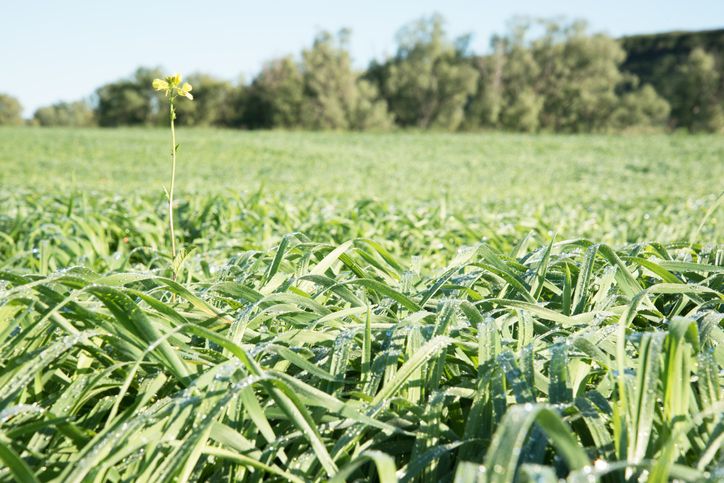Editor’s note: Kenny Fahey is president and CEO of Leading Harvest, a nonprofit working to harmonize sustainability standards across the food sector and scale best practices in sustainable and regenerative agriculture.
The views expressed in this guest article are the author’s own and do not necessarily represent those of AFN.
Some of the largest food and agribusiness companies have committed to ambitious climate targets for 2030 and 2040, but halfway through 2023, they are not on track to reach them.
It is particularly important for the food sector to set and meet climate targets, given that it is a major contributor to climate change: global agrifood systems produce one third of human-caused greenhouse gas emissions, according to the UN Food and Agriculture Organization.
Meanwhile, farmers are on the front line, already struggling to manage extreme weather events amid a changing climate and volatile markets.
Supporting farmers transitioning to regenerative agriculture can help food and agribusiness companies get back on track. While exact numbers vary depending on the farming system, researchers are finding significant carbon sequestration potential through building soil health with regenerative agriculture — not to mention improvements in water quality, drought and flood resilience, biodiversity, and much more.
Already, companies have made public commitments to transition millions of acres worldwide to more regenerative farm management – this is a win for people and planet, and it should be applauded. But in practice, there have been several barriers to large-scale implementation, and there is frustration across the supply chain.
Barriers to large-scale implementation of regenerative agriculture
Here are three of the most important barriers and strategies to break through them.
First, the sector positions regenerative as a binary state, which is limiting the number of farmers that get on board. Many farmers have understood and implemented what is promoted today as regenerative – no-till, cover cropping – for centuries without any recognition.
Now, they are being pulled in too many directions by a supply chain that wants to prescribe them a rigid set of practices. More farmers will embrace regenerative agriculture if, instead, it is seen as a process of continuous improvement. There are ample opportunities to invest in accelerating regenerative agriculture by looking more closely at what is already happening across the supply chain, giving credit where it is due for best-in-class practices, and setting goals for ambitious but practical changes.
The sector needs to rally behind one overarching, holistic framework for sustainable and regenerative agriculture
Second, the sector has not agreed to a common framework for regenerative management systems, which diffuses the investment and effort that is already out there. According to the International Institute for Sustainable Development, there were more than 400 voluntary sustainability standards worldwide in 2021.
Most of these standards deal with a single crop type or narrow issue, and producers, manufacturers, and retailers alike struggle to keep up. Within the umbrella of regenerative agriculture, multiple companies will often target the same producers to join their individual programs.
The sector needs to rally behind one overarching, holistic framework for sustainable and regenerative agriculture, one that invites all on the journey of continuous improvement. This opens the door for aligning incentives and forming more strategic alliances across the sector – and hopefully, multiplying impact.
We have seen this approach work in the timber sector, which in the late 1990s coalesced around two overarching standards – the Sustainable Forestry Initiative and Forest Stewardship Council. Today, hundreds of millions of acres of timber globally certify to these programs, transforming the sector’s practices to be more transparent and environmentally conscious.
On-the-ground validation practices must be strengthened
Third, regardless of what this framework looks like for agriculture, on-the-ground validation practices need to be strengthened. Currently, the sector too often relies on self-assessment. This is likely to limit investment in regenerative agriculture – and in turn, limit its scaling – because neither markets nor consumers will have the transparency and assurance that they need. ‘
Third-party certification is critical to getting past this. This means involving independent certification bodies that are separate from the organization setting the standards, subject-matter experts in the specific areas in which they are focusing, and accredited themselves to internationally recognized accreditation standards.
Also, existing certification methods typically use a top-down, checklist approach that requires farmers to fit into a rigid box. This ignores global agriculture’s incredible diversity of crop types, soil types, and ecological regions. Regenerative systems should instead be built at the farm level, allowing farmers to decide what each of their journeys to regenerative look like – so long as they meet a common framework for outcomes that are third-party certified.
Transitioning to regenerative agriculture does not have to mean starting over
If global agriculture is going to meet its climate targets, it is essential to acknowledge these challenges and work towards harmonization.
The food sector has made ambitious and commendable commitments. Now is the time to rapidly scale success. Transitioning to regenerative agriculture does not have to mean starting over. A common language and validation process can help every step of the supply chain, from farmers to consumers, move towards the common goal: a more sustainable and regenerative food system for all.
Further reading:
PepsiCo to pump $216m into US regenerative ag: ‘We’re putting our money where our mouth is’
KIND Snacks: ‘What regenerative means for almonds vs row crops might be very different’




